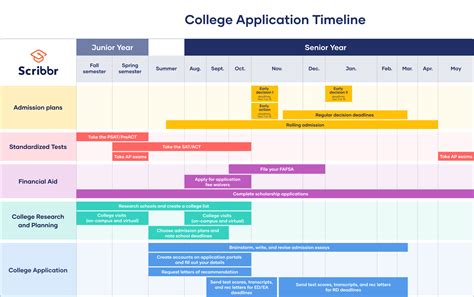As a high school senior, navigating the college application process can be a daunting task. Timing is crucial in ensuring a successful application, and determining the ideal time to apply for college is essential. This comprehensive guide will delve into the various factors to consider and provide a step-by-step timeline to help seniors optimize their application strategy.

Early Action vs. Regular Decision: Understanding the Differences
When it comes to college applications, there are two primary options: Early Action and Regular Decision.
Early Action
Early Action deadlines typically fall in November or December of a senior’s year. By submitting their application early, students have a chance to receive an admissions decision much sooner than with Regular Decision. If accepted, they have more time to weigh their options, secure financial aid, and make enrollment decisions.
Regular Decision
Regular Decision deadlines usually fall in January or February of a senior’s year. Students who apply through this option receive their admissions decisions later in the spring. This format allows students more time to prepare their applications and make final decisions about their college choices.
Factors to Consider When Choosing an Application Deadline
Several factors should be considered when determining the appropriate application deadline:
- Student’s Academic Profile: Students with strong academic records may be more likely to benefit from applying Early Action, as they have a higher chance of securing admissions decisions during the first round of reviews.
- College Preferences: Some colleges have a history of accepting more students through Early Action than Regular Decision. If a student has strong preferences for a particular institution, applying Early Action could increase their chances of admission.
- Extracurricular Activities: Early Action can provide students with more time to participate in extracurricular activities and demonstrate their all-around involvement. This can be advantageous for students seeking to highlight their leadership skills, community engagement, and personal interests.
- Application Quality: Seniors with well-prepared applications may wish to consider applying Early Action to increase their chances of acceptance during the first round of reviews.
Optimal Timeline for College Applications
To optimize their chances of success, seniors should follow a structured timeline for their college applications:
Junior Year
- Attend college fairs and research potential schools.
- Take standardized tests (SAT/ACT) and prepare for future tests.
- Develop a strong academic foundation by maintaining high grades.
- Participate in extracurricular activities and explore new interests.
- Draft a preliminary college list.
Summer Before Senior Year
- Finalize college list and begin preparing college essays.
- Register for and take additional standardized tests if needed.
- Explore scholarship opportunities and apply for those that align with academic and personal goals.
Senior Year
Effective Strategies for College Applications
- Start Early: Begin the application process as early as possible to allow ample time for preparation and revisions.
- Research Thoroughly: Explore various college options, attend virtual events, and connect with admissions offices to gather detailed information about each institution.
- Personalize Essays: Craft compelling essays that showcase unique experiences, perspectives, and passions. Use specific examples and anecdotes to make the application stand out.
- Seek Support: Consult with teachers, guidance counselors, and family members for guidance and feedback throughout the process.
- Proofread Carefully: Review applications thoroughly before submitting to eliminate errors in grammar, spelling, and formatting.
Tips and Tricks for a Successful Application
- Attend Virtual College Fairs: Take advantage of virtual platforms to connect with college representatives and learn about different institutions from the comfort of home.
- Use College Planning Tools: Utilize websites and apps that provide personalized college recommendations based on academic profile and interests.
- Explore Scholarships Creatively: Think beyond traditional academic scholarships and consider niche opportunities based on hobbies, talents, and community involvement.
- Take Advantage of Application Fee Waivers: Many colleges offer fee waivers for students who meet certain financial criteria or demonstrate academic excellence.
- Leverage Social Media Responsibly: Use social media to connect with colleges and learn about campus events and opportunities. However, be mindful of online privacy and reputation management.
Comparative Analysis of Early Action vs. Regular Decision
| Feature | Early Action | Regular Decision |
|---|---|---|
| Application Deadline | November/December | January/February |
| Admissions Decision Timeline | Late February/Early March | March/April |
| Acceptance Rates | Historically higher | Lower than Early Action |
| Advantage for Strong Candidates | Yes | No |
| More Time for Preparation | No | Yes |
| Increased Uncertainty | No | Yes |
Pros and Cons of Early Action
Pros:
- Higher chances of acceptance for strong candidates.
- More time for financial aid planning and decision-making.
- Reduced stress levels during Regular Decision period.
Cons:
- May not be suitable for students who need more time to prepare their applications.
- Involves a binding agreement for some colleges (if accepted).
- Can increase pressure for students who are applying to multiple colleges.
Conclusion
Navigating the college application process requires careful planning and consideration of individual circumstances. By understanding the differences between Early Action and Regular Decision, seniors can make informed decisions about the optimal application timeline. With a well-structured plan, effective strategies, and a positive mindset, seniors can increase their chances of securing admission to their dream colleges.
